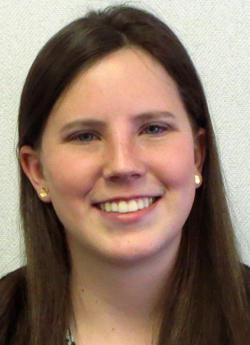
Sarah Mulloy
E-MAIL: [email protected]
PhD 2024
PhD Thesis
Different patterns of acute and chronic alcohol activation of the mesopontine tegmentum across cell-type, sub-region, and sex.
Undergraduate Institution and Major
Wake Forest University, B.S. in Biology, 2018
Graduate Advisor
Anna Lee, Ph.D., Department of Pharmacology
Graduate Research
I am studying the neurobiology of alcohol addiction, specifically the mechanisms underlying alcohol consumption and reward. Currently, I am studying the cell-specific contributions to binge alcohol consumption in the ventral tegmental area (VTA) by selectively modulating either GABAergic or Dopaminergic neurons using cre-dependent excitatory or inhibitory DREADDs (Designer Receptors Exclusively Activated by Designer Drugs) during alcohol binge drinking. In addition to this work, I will characterize the nicotinic acetylcholine receptor (nAchR) subunit expression on dopaminergic and GABAergic neuron populations in the VTA using RNAscope techniques. The goal of my research is to identify the potential nAchR subunits and cell populations in the VTA involved in modulating alcohol consumption and reward.
Publications
Subregion and sex differences in ethanol activation of cholinergic and glutamatergic cells in the mesopontine tegmentum. Sci Rep. 2024 Jan 2;14(1):46.
xpression pattern of nicotinic acetylcholine receptor subunit transcripts in neurons and astrocytes in the ventral tegmental area and locus coeruleus. Eur J Neurosci. 2023 Aug 4. doi: 10.1111/ejn.16109.
Back-translating GWAS findings to animal models reveals a role for Hgfac and Slc39a8 in alcohol and nicotine consumption. Sci Rep. 2022 Jun 4;12(1):9336.
Metformin in nucleus accumbens core reduces cue-induced cocaine seeking in male and female rats. Addict Biol. 2022 May;27(3):e13165.
Flavor-specific enhancement of electronic cigarette liquid consumption and preference in mice. Drug Alcohol Depend. 2020 Jun 1;211:107995.
Graduate Awards/Honors
- Training grant appointee, NIH T32 DA007097 “PharmacoNeuroImmunology (PNI)” at the University of Minnesota, Trainee, 2021-2023; PI Dr. Thomas Molitor
- Training grant appointee, NIH T32 DA007234 “Neuroscience Training in Drug Abuse Research” at the University of Minnesota, Trainee, 2020-2021; PI Dr. Paul Mermelstein
Rotations:
Sade Spencer, Ph.D., Department of Pharmacology
Mark Thomas, Ph.D., Departments of Neuroscience and Psychology
Rocio Gomez Pastor, Ph.D., Department of Neuroscience
Anna Lee, Ph.D., Department of Pharmacology
Undergraduate or Post-Bac Research:
At Wake Forest University, I worked in the invertebrate developmental neuroscience research lab of Dr. Susan Fahrbach studying the experience-based plasticity of the mushroom body brain region in honey bees and paper wasps. I worked on a project studying the impact of neonicotinoid pesticides on the synaptic density of microglomeruli complexes to identify the biological cause for individual forager’s inability to form associative learning in context of colony collapse disorder. After exposing individual bees to pesticides through food, brain sections were immunolabelled for the synaptic protein synapsin to quantify the synaptic volume and density using confocal microscopy. I primarily worked on a project studying the impact of rearing conditions and social experience on the synaptic density of the mushroom bodies in paper wasps to identify the role of the mushroom body in facial recognition. In addition, I worked for a summer in the research lab of Dr. Douglas McMahon at Vanderbilt University studying the impact of neonicotinoid pesticides on the circadian rhythm of honey bees. Each research experience cultured my interest in studying the cellular and molecular mechanisms of behavior and led me to pursue research in the field of Neuroscience.
Undergraduate Publications/Abstracts:
- Hathaway S, Mulloy S, Cely C, Tibbets E, Fahrbach S. The impact of social experience on the synaptic density of Polistes fuscatus. Abstract and poster presentation at SYNAPSE neuroscience conference, April 14, 2018; High Point, NC.
Undergraduate Awards:
Dean’s list Fall 2014, 2015, 2017; spring 2015, 2018
Graduated with Cum Laude, and Honors in Latin.
What Got You Interested In Research?
I have always been interested in studying biology, but I discovered my interest in research after my genetics and molecular biology lab class. We were tasked to identify the mutation of a specific strain of drosophila, from phenotyping with behavioral assays to identifying the genetic mechanism through PCR and gel electrophoresis. It was first time I experienced the complete research process of pursuing a complex question from multiple levels of analysis, and I found it very rewarding and fulfilling! After that semester, I joined a professional research lab to further explore what life in research had to offer- and from that point on I was hooked!
Why Did You Choose MN?
I chose the University of Minnesota for the wonderful research opportunities and the culture of the program. During the application process, I found a wide variety engaging and impassioned research professors with interests that matched my own. I saw a great potential for fulfilling research projects in more than one lab, and incredible infrastructure from the university to facilitate those projects.
In addition, during my visit I was impressed by the supportive and encouraging culture of the program, both in my interactions with students and faculty. I saw a true sense of collaboration between peers, and a strong connection between the students. The philosophy of the program was one of support and encouragement, holistic views on the process to achieve great science, and a large focus on helping each individual student reach their full potential. At the end of the day, I chose Minnesota because I could see myself growing both as a researcher and as an individual.
Student Mentor and the Best Advice They Gave:
Carrie Sheeler has been a wonderful source of advice and encouragement! One of her helpful suggestions was on how to look for a good research advisor, and to start thinking about the first rotation before the start of Itasca so the time at Itasca can be stress-free.
Favorite Itasca Memory:
My favorite memories are the nights spent stargazing at the bonfire, and the one time we saw a wild porcupine rush across the road during the 16-mile bike ride.
